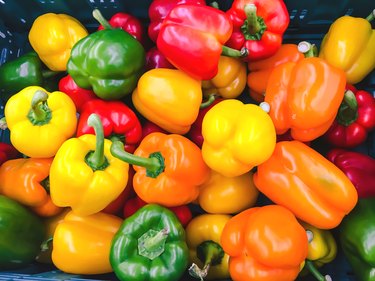
Bell peppers are among the more versatile items in the produce aisle. They can be stuffed and baked, roasted, stir-fried, or tossed in a casserole, but eating raw bell peppers is also a treat. Unlike their more-fiery cousin the jalapeno, bell peppers are mild and slightly sweet, even when raw.
Tip
There’s no reason not to eat raw bell peppers, although most people prefer to remove the bell pepper seeds and membranes first. The American Heart Association notes that bell peppers are the mildest of all of the chili peppers, with a “no heat” ranking.
Video of the Day
Enjoy a Rainbow of Options
Bell peppers, also known as sweet peppers, come in a rainbow of colors, all roughly the same size and shape. Northern Illinois University (NIU) notes that the green types are the less-mature versions of red, yellow, orange, brown, white and even purple varieties.
Even though they're picked at an earlier stage of ripening, green peppers are perfectly edible, and still a good source of fiber and vitamins. You may prefer the more robust taste of the green peppers, or the slightly-sweeter flavor of the red, yellow and other bell pepper types.
Video of the Day
As peppers ripen and change color, they become sweeter. Because of this, green peppers are slightly lower in calories and carbohydrates. According to the USDA, a 1 cup serving of sliced green bell peppers has 18 calories, 4.3 grams of carbohydrates and 2.2 grams of sugar. The same serving of red peppers has 29 calories, 5.5 grams of carbohydrates and 3.9 grams of sugar.
Reaping Bell Pepper Benefits
Nutritionally, mature bell peppers have something of an edge over green peppers, although all bell peppers are healthy choices. Red peppers, for example, have about 130 percent of the recommended daily value (DV) of vitamin C, according to USDA figures. They also have at least 10 percent of the DVs for vitamins A and E, as well as lesser amounts of iron, potassium, magnesium and zinc.
Green bell peppers are also high in vitamin C, with a DV of 82 percent. They also provide about 2 percent of vitamins A and E, iron, potassium and magnesium.
Bell pepper benefits, no matter what the color, also include their fiber content. Red bell peppers provide about 8 percent of the fiber you should have each day, and green bell peppers contribute 6 percent of your DV for fiber.
Consider choosing more than one bell pepper color when you're buying. Different color groups in the fruit and vegetable world represent different types of phytonutrients, according to Harvard Health Publishing. Each color of the antioxidant rainbow can help fight different types of chronic disease.
Read more: Foods to Eat to Avoid the Stomach Flu
Eating Raw Bell Peppers
Cut fresh bell peppers into strips to use for dipping into hummus or a healthy yogurt-based spread. They make a colorful addition to veggies like broccoli spears and carrot sticks. Not only can you use cut-up bell peppers as scoops for dip, but additional bell pepper halves can become colorful "bowls" for the dip itself.
Whether you prefer sweet bell peppers julienne or diced, bell peppers are a colorful addition to garden salads. Don't limit their use to green salads, however — diced bell peppers also liven up shrimp salads, chicken salad, chilled quinoa salad and other warm-weather salad dishes.
Bell peppers of varying shades also add a fresh note to cooked dishes. Sprinkle a handful of diced yellow peppers over lentil soup for extra color and vitamins. Serve rice pilaf in individual, hollowed-out purple bell pepper halves. Or criss-cross strips of different-colored bell peppers over a slice of quiche to create a striking garnish.
Read more: Healthy Snacks to Eat With Guacamole
Prepping Bell Peppers
NIU notes that green peppers are often offered at a better price, because they're picked earlier and don't require the additional labor or supplies that red, yellow, orange and other sweet bell peppers require. Whichever color you choose, make sure the skin's surface is shiny and free of wrinkles or blemishes. Store them in the fridge until you're ready to eat them.
Wash the peppers under running water before cutting them, then dry with clean paper towels. Next, slice them lengthwise, cutting them in half. If you're going to be using them as "bowls," running a spoon along the inside to dislodge the bell pepper seeds is all you need to do.
To ready them for cutting into strips or cubes, cut them lengthwise again, removing any remaining bell pepper seeds and the white "ribs." From there, you can cut them into the shapes that work best for whatever you're preparing.
- American Heart Association: "Cooking With Peppers"
- Northern Illinois University: "Bell Peppers"
- USDA: "Green Bell Peppers"
- USDA: "Red Bell Peppers"
- Harvard Health Publishing: "Phytonutrients - Paint Your Plate With the Colors of the Rainbow"
- Harvard Health Publishing: "Vegetable of the Month - Peppers"